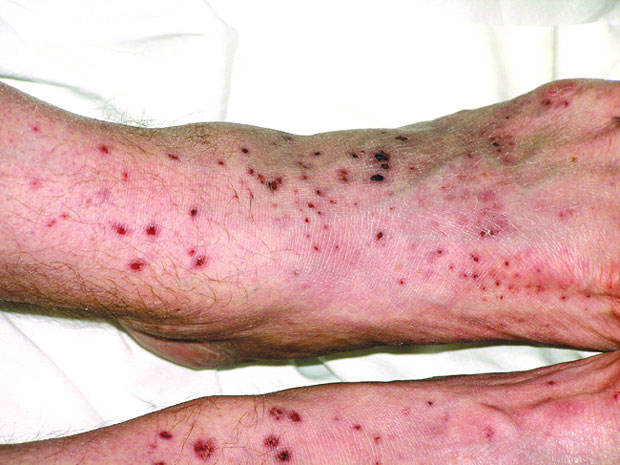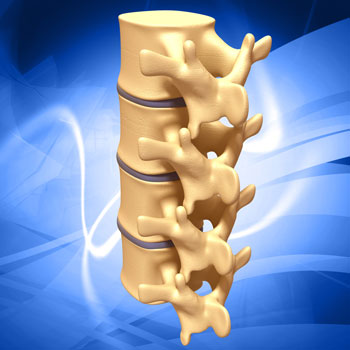MKSAP Quiz: 8-week history of a spreading rash

A 63-year-old man is evaluated for an 8-week history of a spreading rash on the feet and legs, fatigue, and arthralgia.
On physical examination, vital signs are normal. The rash is shown. Some lesions are palpable. He cannot extend his left wrist. Findings on pulmonary, cardiac, and gastrointestinal examinations are unremarkable. There are no swollen or tender joints.
Laboratory studies:
| Erythrocyte sedimentation rate | 110 mm/h |
| Alanine aminotransferase | 93 U/L |
| Aspartate aminotransferase | 89 U/L |
| C3 complement | 113 mg/dL (1130 mg/L) |
| C4 complement | Not detected |
| Creatinine | 2.1 mg/dL (185.6 μmol/L) |
| Rheumatoid factor | 118 U/mL (118 kU/L) |
| Anti–cyclic citrullinated peptide antibodies | Not detected |
| Urinalysis | 2+ blood; 2+ protein; dysmorphic erythrocytes; no casts |
Which of the following is the most likely diagnosis?
A. Cryoglobulinemic vasculitis
B. Hypersensitivity vasculitis
C. Polyarteritis nodosa
D. Rheumatoid vasculitis
Answer and critique
The correct answer is A. Cryoglobulinemic vasculitis. This content is available to MKSAP 19 subscribers as Question 56 in the Rheumatology section.
The most likely diagnosis is cryoglobulinemic vasculitis (Option A). Cryoglobulinemic vasculitis results from cryoglobulin-containing immune complexes depositing in small- and medium-sized arteries, leading to an inflammatory response. Of the three types of cryoglobulinemia, only types II and III (mixed cryoglobulinemia) cause vasculitis. Type II, which usually results from certain viral infections and autoimmune disease, is typified by a monoclonal IgM with activity against IgG (i.e., a rheumatoid factor) as well as polyclonal IgG. Type III is usually associated with autoimmune disease and is characterized by polyclonal IgG and polyclonal IgM. This patient has severe cryoglobulinemia, with new-onset kidney failure, palpable purpura, and peripheral neuropathy affecting the left radial nerve. Cutaneous involvement (palpable purpura, digital ischemia, ulcers, necrosis, and livedo reticularis) occurs in about 90% of patients. Other common manifestations include glomerulonephritis (usually membranoproliferative) and arthralgia without arthritis. Pulmonary and/or gastrointestinal involvement is rare. In addition to detection of cryoglobulins, laboratory abnormalities frequently include depressed C4 complement and low CH50, as well as a positive rheumatoid factor result; this patient's undetectable C4 level in conjunction with a high rheumatoid factor level therefore strongly support a cryoglobulinemia diagnosis. Most cases of mixed cryoglobulinemia result from another underlying condition, the most common of which is hepatitis C virus infection (suggested by elevated aminotransferase levels). Patients with cryoglobulinemia should undergo hepatitis C virus testing and be treated if the result is positive. Severe cryoglobulinemia requires urgent treatment with high-dose glucocorticoids plus rituximab.
Hypersensitivity vasculitis (Option B) can appear as showers of purpura on the extremities but does not lead to systemic disease (glomerulonephritis, hypocomplementemia, neuropathy, and nephropathy).
Polyarteritis nodosa (Option C), a medium-vessel vasculitis, most commonly affects the skin (tender erythematous nodules akin to erythema nodosum, palpable purpura, livedo reticularis, ulcers), peripheral nervous system (mononeuritis multiplex), and gut. However, polyarteritis nodosa does not cause glomerulonephritis, hypocomplementemia, or an elevated rheumatoid factor. It can cause purpuric lesions, but not to the degree seen in cryoglobulinemia.
Rheumatoid vasculitis (Option D) is seen in patients with long-standing and severe rheumatoid arthritis. This patient has no history of arthropathy, and, despite his arthralgia, does not have frank arthritis. The rheumatoid factor level is elevated, but this test is not specific (results can be elevated in chronic bacterial or certain viral infections and Sjögren syndrome, for example). Anti–cyclic citrullinated peptide antibodies, which are more specific for rheumatoid arthritis, are not present. Finally, kidney involvement is present in this case but rare in rheumatoid vasculitis.
Key Points
- Clinical manifestations of cryoglobulinemia include cutaneous involvement (palpable purpura, digital ischemia, ulcers, necrosis, and livedo reticularis), peripheral neuropathy, arthralgia, and glomerulonephritis (usually membranoproliferative).
- In addition to detection of cryoglobulins, cryoglobulinemia-associated laboratory abnormalities frequently include depressed C4 complement and low CH50, as well as a positive rheumatoid factor result.




